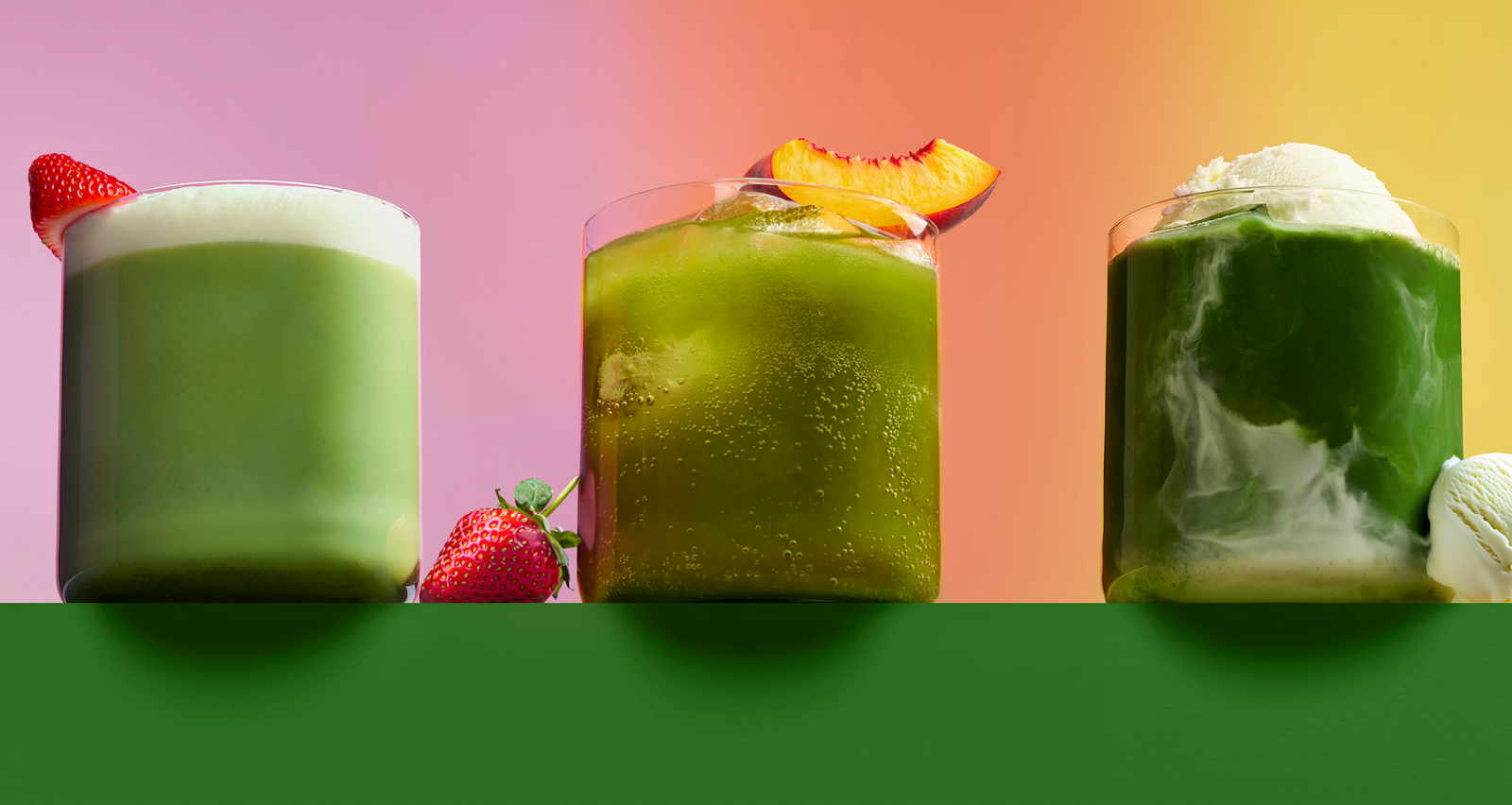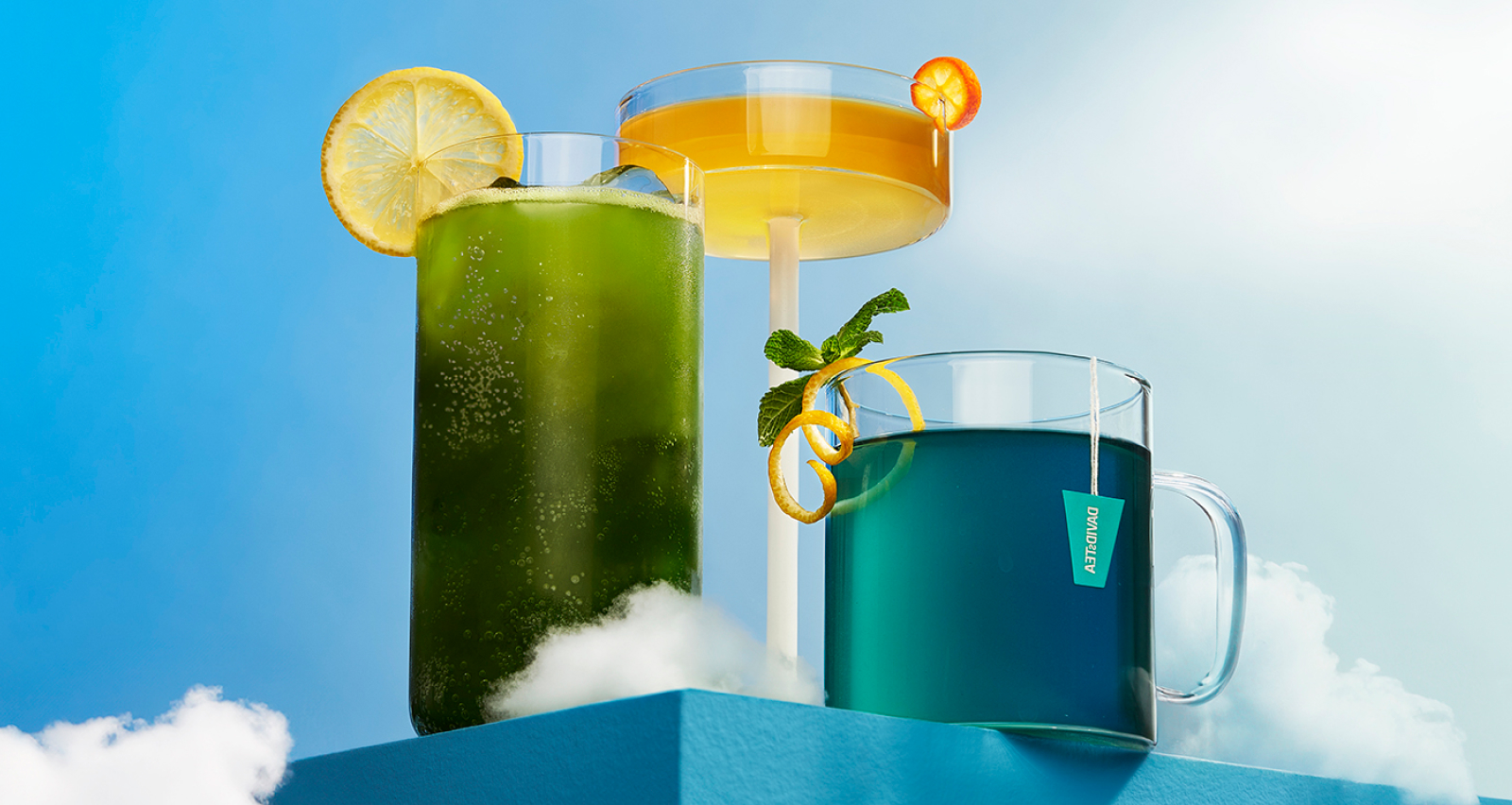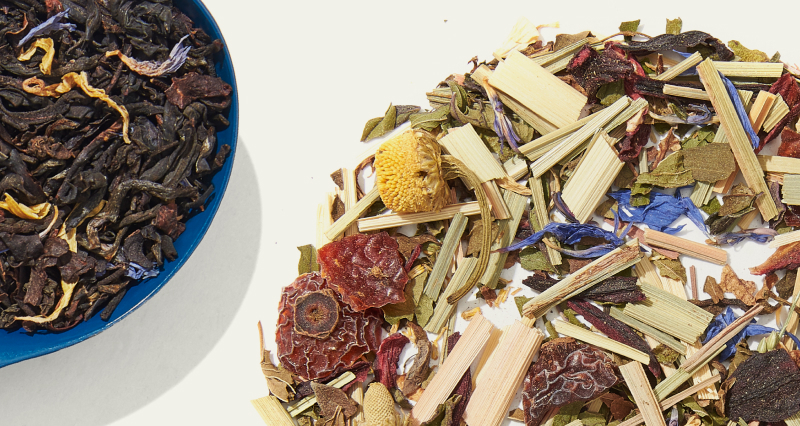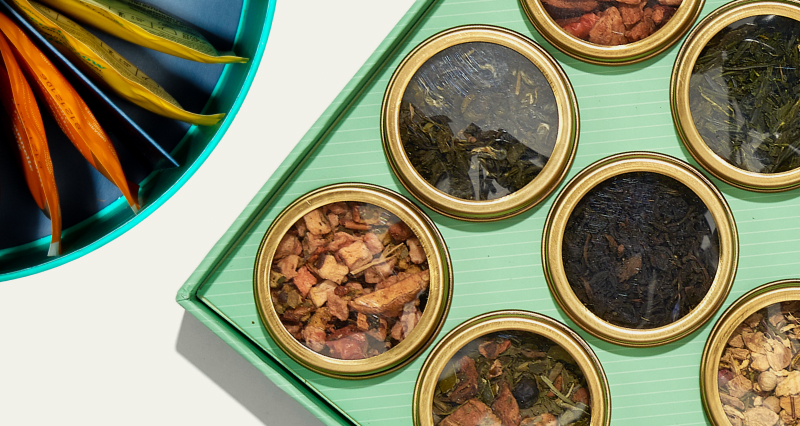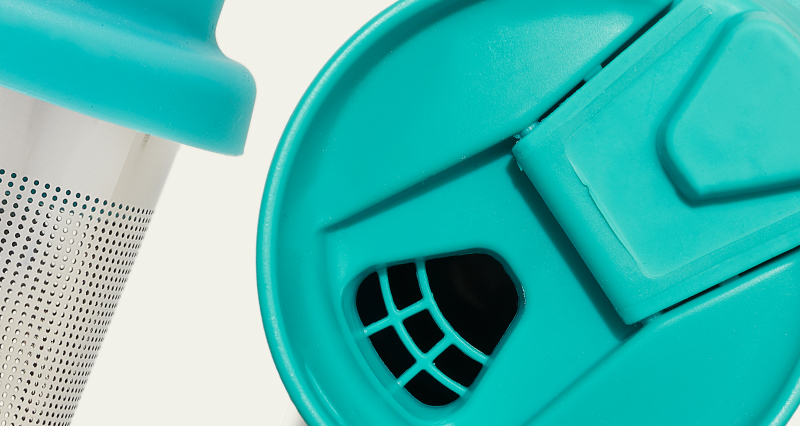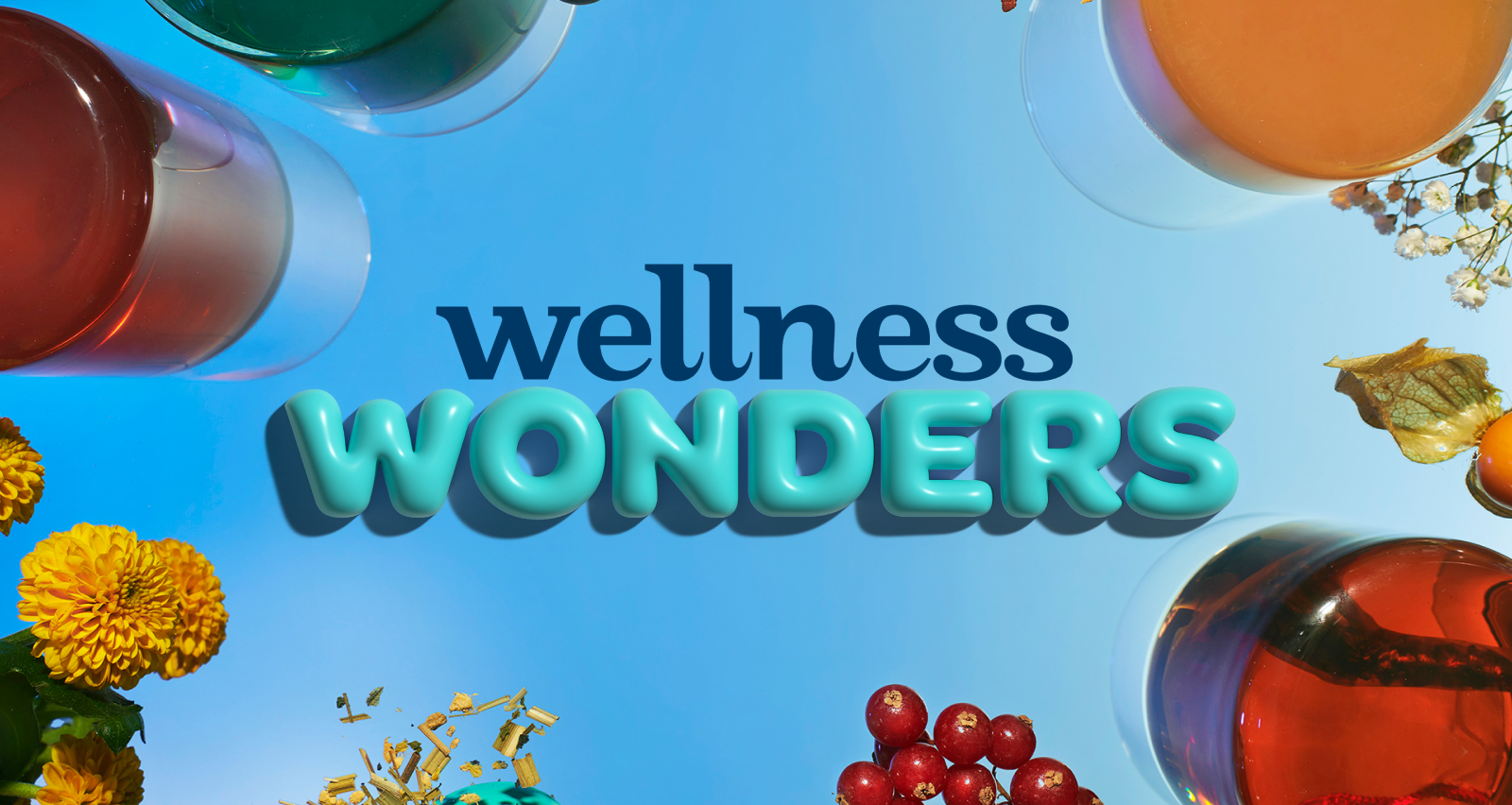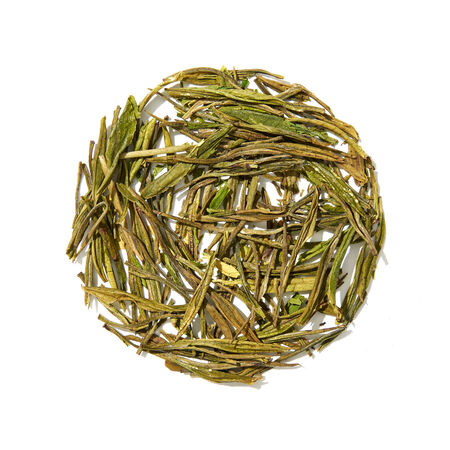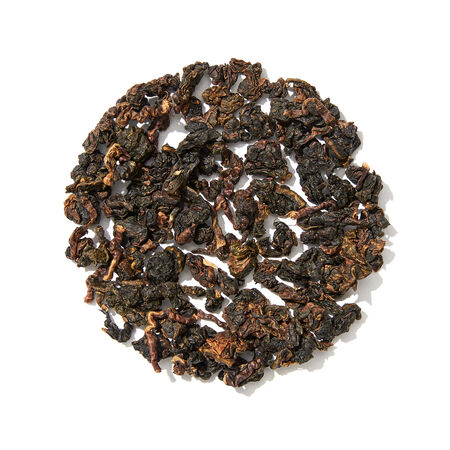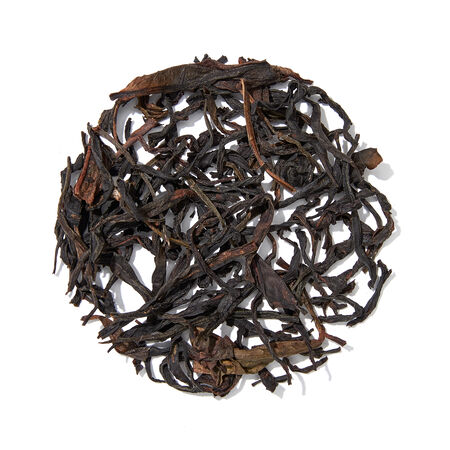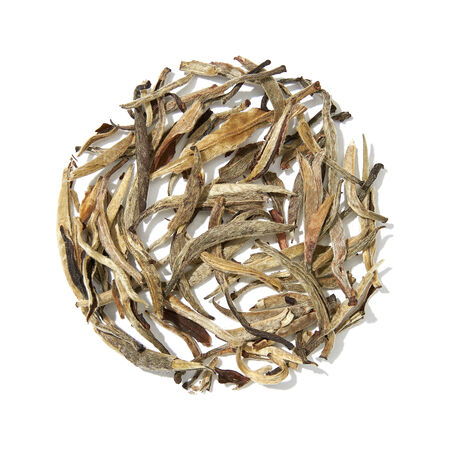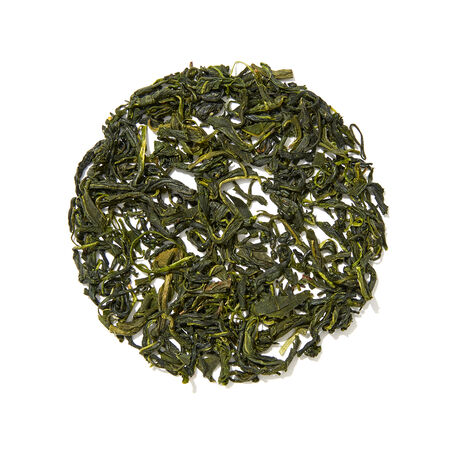season 2 | ep. 13
deep dive into
tea pairings
with Kevin Gascoyne

steeping together podcast
- season 2 | Ep. 13
deep dive into tea pairings
with Kevin Gascoyne
episode transcript
Marika de Vienne 0:18
Welcome everyone to another episode of Steeping Together, the podcast where we explore the vast world of tea over a cup of tea with a tea enthusiast. I’m your tea-obsessed host Marika and as usual, I am so excited to be with you all here today. Oh tea pairings! At once an enticing endeavour yet completely overwhelming to most people. How do you pair a tea with the proper foods? Where do you even start? Do you like start a chart with all the flavour notes of your tea? Compare with the notes and various foods in a separate column? Then do a VLOOKUP to a flavour wheel and hope that Excel will somehow magically provide the perfect answer? Well, it needn't be that complicated. Here to get us started on understanding the world of tea and pairings is one of the founders and owners of the Camellia Sinensis teahouse, Kevin Gascoyne. Welcome, Kevin!
Kevin
Thank you very much.
Marika
It is a delight to have you here with us.
Kevin
Well, it's lovely to be here.
Marika
Would you care to introduce yourself the way you'd like to be introduced?
Kevin Gascoyne 1:25
Well, my name is Kevin and I own a tea company by the name of Camellia Sinensis, which is the, as most of you know, is the botanical name of tea. I have three partners. We're a group of tea tasters. And we run a company that is based on our purchases that we make in Asia every year, we have a catalogue of around 250 teas. It's an ever changing catalogue. Every tea is bought directly from the grower by us and bought on location. So we follow the seasons, we follow the best teas of each region. We're kind of niche because we do very high end stuff, small lots, rare lots and so on. But we have our own little market for it. Around our wonderful catalogue of teas, we have retail stores, we have three retail stores in the Quebec, Montreal area. We sell to a lot of other tea companies. And we also sell to, we have a range that goes out to wholesale customers, cafes and grocery stores. We also do education and publishing, we have our main principle book is published in six languages now,
Marika
Congrats!
Kevin
Twice won world's best tea book. What else do we do? We do, we run schools in education. We do a lot of conferencing around the world. I do field consulting also as a taster. So helping growers develop their products. And in the last few years, we opened a tiny mini factory in the south of India called the tea studio. Which I think we can probably give the listeners the email for that after. The website.
Marika de Vienne 3:17
Oh, yeah, no, I think yeah, the website, absolutely we’re gonna be sharing!
Kevin Gascoyne 3:25
The tea Studio is a small artisanal project in south of India, where we make our own tea. So we do everything now. From producing to retailing to the customer.
Marika de Vienne 3:42
My goodness, you do a lot, you're a pretty–! You do a lot. And I have to say that the Camellia Sinensis website is one that I actively try to avoid. Because every time I go to your website, it ends up being quite the cart that–I mean I am, I have some absolute favourites that you've kept over the years, I've had some favourites from way back in the day. The quality of your product is outstanding, the friendliness of the service of the people in the stores and the kindness of just you and all the other owners is just, it doesn't always match up with the gravitas that people would assume. Like that you guys have, you know. We think people with that high end tea and they take it so seriously, and they're going directly to source! Like, it's always slightly intimidating. Like are they going to let me in? Are they going to talk to me? And always so welcoming, always so full of information.
Kevin Gascoyne 04:38
Yeah, I think it's that irony, that we do that with a passion. We're very directly connected to the people that make the teas that we bring in. And so that kind of separation and mystery is sort of removed at that point. It's like very cool people making tea, us going to get it, and bringing it back to sell to our very cool clients. So it doesn’t need to be complicated, more complicated than that.
Marika 05:15
Right. And that is one of the reasons I asked you to tackle this particular subject, tea and pairings. Because I think people make it out to be more complicated than it needs to be. But there are some ground rules. There are some things we can work around. Now I'm going to start with a question. Whenever I look at tea and pairings, the number one teas that are paired with you name it, is Darjeelings. And given that you are the Darjeeling expert of Camellia Sinensis and the Darjeeling expert of almost any given room, you enter.
Kevin
Yes.
Marika de Vienne 5:45
I mean, you've been going to that region for how many years now? Yeah, there's an intimate connection you have with Darjeeling?
Kevin Gascoyne 5:54
30 years–
Yes, I know, pretty much everybody. And they all know me.
Marika de Vienne 5:56
And that's not really an overstatement. I mean, this is a really small region. I mean, everybody knows the name Darjeeling or has had contact with tea from that area. But it's not a very big place in the world.
Kevin
It's not a big place. And I've been hanging out there for almost a month every year for the last three decades. So yeah.
Marika
What's so appealing about it?
Kevin Gascoyne 6:18
Well, the tea, it’s the tea that mostly appeals to me. It's highly caffeinated, and very bright and lively flavour profiles. So I like that, I like the complexity. Each of us has our favourite tea that tastes like the complete flavour of tea for us. And that's always been mine. And obviously, the Himalayas, it's a beautiful region! Darjeeling is in the foothills of the Himalayas, you can see the white peaks and so on. And I love the people up there. They're great people. There's a really nice cultural vibe up there. So all in all, it's all-around package. I started going there was totally charmed by the place, the tea, the product, just the whole thing. So yeah, so I've been going back. I do a lot of other regions as well. But certainly my heart would be there.
Marika
Your heart’s in Darjeeling?
Kevin
Yeah, yeah.
Marika 07:19
That's a beautiful thing. I wish, I hope to see it one day. I mean, it sounds heartbreakingly beautiful and just a fascinating place to visit. So, Darjeeling is paired with anything. I’ve seen Darjeelings paired with cheeses and chocolates and all of these kinds of things. And I wonder if Darjeeling is paired with food as a reflex because it's considered like the champagne of tea. So if you pair anything with a Darjeeling, you're going to have a nice experience. It's almost, sometimes it feels lazy. You know what I mean? Feels like champagne and strawberries, champagne and chocolate. Well look, champagne goes with a great many situations, moods, and foods. It’s kind of an easy choice. Am I correct in that view?
Kevin Gacoyne 08:01
There's a little bit of that, there's a lightness, but some dealings are a little too complex to mix with some other flavour profiles. I think, I think the first thing I would say about pairing is there are sort of three things that can happen when you pair things together. The first one is you get a complement, where things will, two flavour profiles will kind of fit in fit next to each other like two jigsaw pieces. So that's very interesting because they tend to enhance parts of each other's flavour profile. The next one that it can be very interesting is a contrast, where they don't really go together but one of the flavours will perhaps cover up half of the others’ flavour, highlighting and enhancing a part of the other food or the other drinks flavour. So you get, you get them splitting up, you get to taste different parts of the flavour profile that you can't when you just taste them on their own because they're differently made. And then we have this third magic that sometimes happen. When you get a bridge, you get some form of a beautiful, chemical, aromatic bridge between the two. And you have this sort of marriage that gives you something that is bigger than the sum of the two parts. So that doesn't always happen. But there are certain flavour mixes that work really well. So if I'm doing a scotch and tea tasting, for instance, which is quite a common one, there are two things that go very well together. I will always do one of each to show those three different facts of having two things that go together, and then having the complement, the contrast, and then the harmonic bridge. Always do the harmonic bridge at the end, so you get the wow at the end, obviously.
Marika 10:06
Interesting, I just, I love how you described it. As you were describing it, I really thought, I don't know why I thought about this, I thought about different like couples that I know.
Kevin
Oh that’s good!
Marika
Like people, like there's some couples that really complement each other and they both enhance each other. And they are definitely better off for having the other in each other's life. Then you have the contrasting couples, I'm thinking of a particular couple in mind, but who are just very different personalities. Get along, have found their commonality. But you know, there's the loud one and the quiet one or the funny one and the stoic one, and you love having that couple around because they bring a different contrast into it. And the bridge really feels like what Hollywood's been convincing us is a perfect–
Kevin
Soulmate.
Marika
Is a soulmate, exactly! The soulmate! Like that we've found these two elements that have come together to make a bridge, and it is an undeniable pairing for the ages!
Kevin
Yes, yes! Greater than the sum of its parts.
Marika
Greater than the sum of its parts, exactly! And so as you were saying that, that's all I could think about. And I feel like that's a really good first step when deciding on what you're going to do with your pairing. If you want to–do I want to complement, do I want to contrast? Or do I want to shoot for the stars and write a love story of which Shakespeare himself would be jealous? You know? All right, so let's talk about complementing. Let's break it down. Give me some good complements!
Kevin Gascoyne 11:40
Okay. All right. Well first of all, I do need to say that we've started with the overall kind of concept. But we don't want to make, we don't want it to be complicated. We want it to be fun. And it's the exploration that's the fun.
Marika
Exactly, yes.
Kevin
So there are obvious things that don't go well together, obvious things that rarely work together. One of them, the first thing I think is wine and tea. Wine and tea are very difficult to pair, because they cover up a lot of each other's flavour profile. So one of them tastes dead when you taste the other one. So if we're doing pairing with wine, we do something a little bit different, where we try to compare a tea with a wine that has a similar sort of essence to it, that has a similar sort of character. Maybe it's bright and lively. Or maybe it's round and earthy or something like that. Something that has a little bit more of a character complex, but we can't necessarily do it in the sandwich formation that we use when we do when we’re tasting whiskey. So with when we taste tea and whiskey together, they go beautifully together. The hot and the cold, and the preparation of the mouth with the tea and then the warmth and what it does to the Scotch in the mouth, or the bourbon in the mouth, and then back to the tea. We call this the sandwich, we do tea–Scotch–tea.
Marika
Nice. Okay.
Kevin 13:14
So that's just a methodology. But there are some things that work and there are some things that don't, some things that definitely don't. So wine is a hard one. Whereas if we look at wine with cheese, wine and cheese is probably a mix made in heaven, say.
Marika
Absolutely. Yeah.
Kevin
And then if we go deeper into a wine and cheese, then we have wines that go better with creamy cheeses, and you’ve got wines that go better with sharp cheeses and that kind of thing. So I think the fun is, well obviously the fun is when you find that perfect marriage. But the fun is the exploration. I think it's hard to, until you've started doing it a little bit and you've started exploring, it's hard to put–it's hard to anticipate what's going to happen. You've really just got to jump in–
Marika
Trial and error.
Kevin
And start trying things next to each other and see whether it's going to fit, whether it's not going to fit, and without fear, really.
Marika
It sounds like a lot of fun!
Kevin
And without thinking that we can do it wrong.
Marika 14:23
Right, exactly! I think that people think oh, I'm gonna do it wrong. Yeah, it's kind of like look if you enjoyed it, it's a good pairing!
Kevin
Exactly.
Marika
Is it something that you should present to your mother in law? Depending on the relationship you have with this person, you know what I mean?
Kevin
Depending on the mother in law.
Marika
Depending on the mother in law, like if you're doing it for yourself, or you're doing it in a fun casual environment with you know, people that are also there to discover, also there to try. Just try it. Just try it.
Kevin Gascoyne 14:57
Just try it, it’s the thing to do. And we sometimes have this, I think we were talking about it earlier on, this thing about not being expert enough, not really knowing where to start. Other people know how to do it, I don't know how to do it. But we all know how to eat, we all know how to taste. If we can get into that space where we're focusing, that's the hardest part really, is just focusing on what we're doing, just like tasting without other white noise going on in your head. And you can do that, you can just take a split second from a conversation at a party with your cheese and wine, and just one second one split second, you have a moment of tasting, and then you're back in the conversation. So to create those little moments, it could be a micro moment, or it could be set up and a little bit longer with some different cheeses and some different teas or some different wines or something. And to get in the headspace, I think that's really what it is. It's getting into that headspace where you are focusing. Because that's hard to do. There's so much going on all the time, all around, life’s so busy, you know, it’s hard to get to that point.
Marika de Vienne 16:20
It's so–sorry, I'm laughing to myself, but it's because it's so impossible to carve out these days, just a moment, just 10 minutes, where it's just you, and your feelings and your flavours and all of that. And it's such a gift that we can do it through tea or wine or any kind of food, like you should definitely give yourself that gift.
Kevin
Yes, I think so. I I've been wanting to make a t-shirt actually Ttat goes on the “dance like nobody's watching.” I'd like to have a t-shirt that says “taste like nobody's talking.”
Marika de Vienne 17:06
Sold!
Kevin
Just so people have that moment, just it really doesn't need to be long. Where you just indulge yourself in beauty of using all your sensorial equipment, just for a split second. It could be longer. And if you really get into it, it could be much longer. And, you know, some of us in the industry, we'd love doing it and we do it as a living. But I think it's just a little habit that you need, that you need to pick up. Instead of chugging the wine, eating the cheese and carrying on chatting. You just have that very split second where you sit, you eat and then you’re back to the conversation. Maybe you didn't even share what you thought. But you felt it fully.
Marika de Vienne 17:51
Exactly. And if somebody asks you Hey, where did you go? It seems like you're lightyears away in the middle of the conversation, because you took that moment. So yeah, man, let me tell you, I went on a little adventure, a little flavour adventure that I highly recommend.
Kevin
Yeah, you wanna come?
Marika
Conversation starter!
Kevin Gascoyne
Conversation starter. And you know what, nine times out of 10 people find it really interesting because they never do it.
Marika
They never do it and humans are so motivated to discover new flavours, everything we do is almost towards that new flavour. I mean we all, we eat three times a day, we snack in between, we have this drink, that drink, and the number one decider for what we're going to consume is flavour yeah, I've never really met anyone who’s like ah I don’t care what it tastes like. Really? Really, not even salt? You don't, you have no opinion on this…So yeah, it is a great conversation starter. Okay. You've said about 10 things that my brain has just been firing off, I have so many threads I could pull on but I just want to go back really quick because talking about wine and tea. I'm not a drinker. I don't, I'm a tea drinker. I don't generally consume alcohol and when you said if you want a pair of wine and tea I was like oh I've literally never thought once of pairing a wine with a tea. As soon as you said it I did have that reaction of like, oh that's not my natural inclination to put those two together. When you said Scotch or whiskey with tea, that clicked for me, not just because I may or may not have attended the seminar at the Camellia Sinensis school on scotch and tea. But because those hard alcohols they also create a different mouthfeel and that different burns sensation in your throat and so you're not just contrasting or complementing flavours you also have that textural component–is that a word, did I just invent a word? Textural. Textural, that’s what I wanted to say. But you also have that textural component that's a really interesting play off each other, whereas wine and tea are in the same kind of texture. Not all of them. But in my mind.
Kevin Gascoyne 20:11
Yeah, but if you don't drink wine, try grapes and tea. That doesn't work either.
Marika de Vienne 20:16
Right! Okay, oh, grapes and tea. Yeah. As soon as you said it, I put it together.
Kevin Gascoyne 20:19
They don’t work. Grapes and cheese are fantastic, but grapes and tea don’t work.
Marika de Vienne 20:23
So all of this leads into my next question, how important is a textural complementation? Contrast? You know, how important is that mouthfeel, when we're talking about pairing?
Kevin Gascoyne 20:38
It can be the focus. And it can be unimportant. But usually, depending on what, what two things you are comparing, for instance, if you do a tea and cheese you've obviously got very different textures.
Marika
Yeah, solid, liquid.
Kevin
In your mouth. One is creamy, one is clear, and so on. But you can have teas that have a more creamy edge to them. And you can have cheeses that are perhaps more, a little more crisp. And for sure one will highlight the other one. When you do them one after the other. Yeah, same with scotch, as well. Yeah, I think just putting two, even if you do two teas, one next to the other, texture is one of the first things. And actually when I'm doing a tasting with a large amount of people, one of the first things I will say, to get them into the zone we've just been talking about, where we're actually focusing, is forget about trying to compare this to flowers and fragrances that you know, or memories or poetry or anything. Just focus on the texture. Because that gets you into that place of focusing straightaway. And then okay, the texture because they probably wouldn't have thought of that. But they can feel it easily, before they feel that they have to analyse like some wine sommelier that's discussing the notes of the harvest.
Marika de Vienne 22:09
Yeah, like name the obscure flower from Malaysia that this note reminds you of!
Kevin
Exactly, exactly.
Marika
So leading them in with texture.
Kevin Gascoyne 22:20
Lead them in with texture, because then they're in there. And then at that point, we can talk about how the flavour develops in the mouth, whether it opens fast or opens slowly. Whether it has a nice long aftertaste, or whether it's finished soon. Then, at that point, once they've started to analyse the texture, then it makes it easier to just be in there and start having a look around.
Marika de Vienne 22:50
Right, it's a lot less intimidating. …Because it is, texture is touch and sensation. And it's kind of a nice way of saying what are you feeling, what are you feeling right now?
Kevin Gascoyne 23:00
Exactly. And the texture is probably something that everybody's feeling, because we all have very different tastes, tastebud reactions. So some people are tasting a lot more of this or a lot more of this, etc. but the texture is fairly the same food throughout different people.
Marika de Vienne 23:19
I like everything that you're proposing. Because, correct me if I'm wrong, I feel like what you're proposing here is a “choose your own adventure” style approach to pairing.
Kevin Gascoyne 23:28
Exactly, exactly. Yeah.
Marika de Vienne 23:31
There are concepts that can enlighten and guide you through the fun of it all. But at the end of the day, grab your sword, grab your shield, get your mug. A choose your own adventure!
Kevin Gascoyne 23:46
Yeah. Pop by the tea store, grab a bottle of scotch.
Marika de Vienne 23:51
I really like that, I really, really like that. Because it’s just as we said, just very, very intimidating with people and they should need to just try it.
Kevin Gascoyne 23:59
Yes. Well it’s the same with a lot of things. Even when people are coming to me and saying, well, Kevin, I don't really know. You know, I don't know much about tea. I bought this oolong and I'm not sure how to make it, I've been weighing it and timing it. And this that ant the other. And I say well, it sounds to me like you're so focused on the laboratory system of your infusion, you're not actually paying attention to what the tea tastes like. So what I recommend is that if as you get into tea, or as you get into pairing, in this conversation, you do one or two organised and then you do a third freestyle. So if you're doing, say you're learning to infuse with a Gong Fu Cha teapot, you do one or two where you're measuring and measuring the temperature and everything else. And then you do one freestyle, because that's when you start to really have this inherent intuition about what's actually happening. And because you're not focusing on the beats and the clocks and the tape measure, the weighing scale, and so on, you're actually focusing on the aromas and the steam and the feeling and the fragrance in the air. So I think it's really important to have the confidence that we're in our own driving seat in all these situations. And that anything could be a pairing, I mean, picking up two things while you're cooking and trying the two of them in your mouth at the same time is going to give you some form of information and build up your filing system as to how two things are going to go together, or not go together. And it's just as interesting doing things that don't go together, as do go together. Because there's a lot to learn in that.
Marika de Vienne 25:57
And in the spirit of that kind of, you have the equipment to do this. And you can choose your own adventure, you are already equipped. One of the things I always tell people is your brain has recorded everything you've ever tasted. And when you get into the habit of tasting certain foods, depending on where you are geographically, culturally, all those things are taken into consideration. You do know automatically what pairs well, together. It's an instinct that you develop over time.
Kevin Gascoyne 26:33
Yeah. Or you start to think that anyway. Or you start to think, I must try it.
Marika
Exactly! Yes!
Kevin
And sometimes you get completely surprised. Which is very interesting.
Marika de Vienne 26:42
It’s always interesting when you're like, Oh, that was absolutely going to work. On an intellectual level, I knew that was going to work. And then you do it and it's an unmitigated disaster. Really interesting.
Kevin Gascoyne 26:53
I did quite a lot of tastings on with using molecular gastronomy, Francois Chartier. About, I don't know, 15 years ago. And that was very interesting, because you discussed at the beginning chemical breakdown and looking for molecular bridges, and so on. So that's what he specialised in and wrote a few books about. And that was fascinating. But in many ways, it was kind of digital. Because it was a little too precise, right? And it taught sort of took the soul out of it a little bit. It was, I mean, it was a scientific approach to doing this idea of putting two things together. And yes, tomatoes and chocolate and various different foods share molecular flavours, molecular flavour elements. So they do go together, you know, asparagus and chocolate have some of similar molecular elements to them. When you put them together, they make this very strange combination that doesn't taste like either of them. So it is, that is fascinating. So if you want to go for a deep dive, that's one thing you can look at as well. But I would say that just getting familiar with going for a little trip into that back catalogue that you just mentioned, of all your flavour experience, and pulling a few things out and just like slamming them together and see what happens, I think is, I mean it's just fun.
Marika de Vienne 28:36
It's just fun. It's just a fun thing that–
Kevin Gascoyne 28:39
It’s just a lot of fun.
Marika de Vienne
It’s just a lot of fun!
Kevin Gascoyne 28:40
I mean, why are we doing it in the first place? I mean, you know, maybe we're doing it to impress our friends, but you want it to be fun.
Marika de Vienne 28:51
Exactly. No, I think it's fun to play with those flavours. It's fun to play with your own perception of flavour too, and to confront what you thought you knew by trying new pairings. You know, choosing your own adventure, as we said, I've now said it eight times. I'm going to have to trademark it for the purposes!
Kevin Gascoyne 29:09
Choose your own adventure.
Marika de Vienne 29:14
Choose your own adventure! So one thing that we did discuss before recording, you said very casually to me, you said dunking a biscuit in tea isn't pairing, and I went what, what do you mean? And look, just because something has been done for hundreds of years doesn't mean that it's…
Kevin Gascoyne 29:36
Well I mean that’s a natural pairing. They’re two things that go beautifully together, we know that. We know that. So it is a pairing, of a sort.
Marika de Vienne 29:44
Okay but why did you phrase it that way? It was it was so like, it’s not a pairing, I was like, oh my! I feel like this is a conversation you've had before.
Kevin Gascoyne 29:54
No, no, I just came up with it while we were chatting. I think it was because, I think it's because a lot of people will do it just without that moment of thought, that I want, that I needed for it to be. It's more of a combination than a pairing because there's not that thought moment of thought. But at the same time, the visceral information of a pleasing combination of two flavour elements is there, you know. The vanilla or the shortcake or the butter in the biscuit and the tea. And they're all things that have been designed over decades to go together and recipes that have been refined on both sides. The tea and the biscuit.
Marika de Vienne 30:36
Oh, well, I love the specificity we've now brought to it. No, because it's the action of pairing that requires that mindfulness, that requires…
Kevin Gascoyne 30:47
Mindfulness, yeah, it's like drinking tea and tasting tea. Now that it's just a frame of mind, really.
Marika de Vienne 30:55
Oh man. We could do a whole episode on frame of mind for tasting.
Kevin Gascoyne 31:01
Yeah, we've already got about six t-shirts.
Marika de Vienne 31:06
It's time to open a shop. We've already got one convinced customer. So Kevin, we've been drinking tea this whole time, because I don't know about you, I almost never have a conversation without tea. It's very rare that I–
Kevin
I don't do anything without–
Marika
I know! I don't really have a moment in my life where there isn't a tea at least at arm's reach. You have the distinction of being the first guest to whom I've presented several options of which tea we should drink and you picked all three.
Kevin Gascoyne 31:39
Of course. I want to see how they go together.
Marika de Vienne 31:42
So okay, so we have an anji green, an anji bai cha. Green tea.
Kevin Gascoyne 31:48
Which you know is one of my favourite green teas. I don't know how you found that out.
Marika de Vienne 31:52
I have my sources so I'm not gonna divulge that. It's also one of my favourite green teas. Something that I learned about for the first time when I was living in China. And I am not predisposed to drinking green teas typically. I don't look for that flavour profile necessarily on a day to day but I just really like the Anji Green, the body that it gives.
Kevin Gascoyne 32:16
So lively and bright.
Marika de Vienne 32:18
Yes, it's not judging me. I feel like this tea is not judging me! I don’t know how else to put it.
Kevin Gascoyne 32:22
It's hard to make it badly as well.
Marika de Vienne 32:26
Exactly. I like how you say that because I'm the one who made it, you're like see you can do it!
Kevin
Even you made it well.
Marika
Even you! Then we have a Phoenix Oolong, which is a dan cong oolong from southern China. I love dan congs. Oolong’s my favourite tea category generally speaking, be it the greener ones or the darker ones. This dan cong is just slightly spicy, it's a good everyday cup. It's, to me it's a mug tea. It's a great mug tea because you can just–
Kevin Gascoyne 33:00
That’s the one I've been tucking into on the table actually.
Marika de Vienne 33:03
Right? Yeah, I really like this one. And then we have Cinnamon Oolong.
Kevin
I haven't tried that one yet.
Marika
Oh, we're gonna have to remedy that.
Kevin Gascoyne 33:10
Yes. Put some in my cup.
Marika de Vienne 33:13
There you go. I love this tea. We've talked about this tea on the podcast before, it's an oolong that is scented with cinnamon. Did not have cinnamon added to it.
Kevin Gascoyne 33:22
Yes, it's nice.
Unknown Speaker 33:24
I love it. I'm happy you like it.
Kevin Gascoyne 33:25
I'm not a big cinnamon fan. I usually find it too sickly but this is very well balanced.
Marika de Vienne 33:30
I really enjoy this cup and for people especially who say they don't like cinnamon I'm always like give this one, give this one a try.
Kevin Gascoyne 33:36
Yeah, yeah I really don't like cinnamon and I'm enjoying this.
Marika
Well that's a lot!
Kevin
Well I think cinnamon is just overdone. It's put in everything, it's you know it's like vanilla was in the 80s, you know, cinnamon they just went nuts with cinnamon and put it in everything. And it's not supposed to be like comfy slippers and warming but it's just really overdone and there’s so much bad cinnamon around, an artificial cinnamon, I just–But this is nice.
Marika de Vienne 34:08
I think also like when you're sleeping cinnamon, when you steep the wood, cinnamons bark, it doesn't always sleep at the same time as the tea. So it's always hard even to find that balance with some of the teas and so here you don't have that issue. You can just steep it and you’re good to go. Do these pair at all with each other? I am not seeing it but I'm not–
Kevin
Let me see, let me see.
Marika
I like how you just shot that back!
Kevin Gascoyne 34:37
Not wasting it. The cinnamon to the dan cong works quite nicely. The cinnamon sort of hides the central flavours but the dan cong’s more floral. So it becomes quiet, a quiet body but a larger bouquet. And also the texture is more clear and crisp with the dan cong. So that's nice. Now I'm gonna do dan cong to Anji Bai Cha. I’ll just take a shot of each… yeah it makes the Anji nice and bright and green, yeah. You can actually taste the floral side of the Anji a little bit more after the dan cong. So that was simple, we just launched into a little pairing just because we have three flavour elements on the table.
Marika de Vienne 35:26
Right! That was simple! What did–what did–what did you–[sputtering].
Kevin Gascoyne 35:32
Well, I had to stop talking, that was one thing. Rule number one, I had to think.
Marika de Vienne 35:40
Yeah, so you did stop talking. Which is no small feat for me. But we did stop talking.
Kevin
I stopped listening.
Marika
Stopped listening, exactly! You zoned out. Um, what of the three types of pairing that you described would you say happened here, like the Phoenix Oolong and the Anji. Was it a complement, was it contrast, was it love.
Kevin Gascoyne 36:03
Contrast for the first one. No, there was no love really. The second one was kind of a complement.
Marika de Vienne 36:11
Interesting, interesting. I feel like that's a really good exercise that people can take away, is kind of take three teas and see who plays well with the other.
Kevin
There you go.
Marika
Try this one with that one and then try this one, that one, and it's a fast way to kind of bring out the best in each tea and bring out new potential flavours.
Kevin Gascoyne 36:29
Yeah I do this quite a lot. I did a tasting with a group just a couple of months ago actually, with three pairs of teas. Darjeelings and Wuyi oolongs, further North than this oolong. And again I did the three styles, of two that went together, two that contrasted and then a harmonic bridge. And I was doing it with a very deep group. So I could take them deep into the tea, into the teascape. And so we were working on what happened halfway through the flavour. There was a dip and a matching flavour, flavour elements and so… but yeah, two teas works together.
Marika de Vienne 37:22
I don't know, as soon as you said deep group I was really envisioning, you know, cloaks, silence. Very Gandalf situation. I mean, I love it. It's fascinating. I think I've learned a lot. Mostly, the big takeaway for me is to just give yourself that time and that you have the tools to do it.
Kevin Gascoyne 37:48
Yeah. Just take a moment. Now and again, just to taste the things that you taste and think about them.
Marika de Vienne 37:55
Well, that's very encouraging. I think we should keep drinking. And we'll be right back.
Kevin Gascoyne 38:01
Yeah, we'll be right back.
AD BREAK 38:04
Today's episode of Steeping Together is brought to you by our Garden to Cup collection. What's a Garden to Cup tea you ask? Our Garden to Cup teas are a thoughtfully curated selection of traditional and single-origin teas sourced from gardens across the globe. We have everything from classic staples like Orange Pekoe and Organic Japanese Sencha, to ultra-limited and small-batch teas like Wild Grown Rooibos and Zomba Pearls. Not only are these teas incredibly delicious, but they're also some of our favourites to source. Why, you ask? Well, Mother Nature and the incredibly skilled people working these gardens have done all the heavy lifting for us. And for that we could not be more grateful. Garden to Cup teas. Yeah, we sell stuff without sprinkles.
Marika de Vienne 38:56
Welcome back, it's time to play “What Are You Drinking?” the quiz where we ask our guests three situational questions, some realistic, some completely out there. And they have to use all of their experience and expertise to tell us what they would drink in any one of these given situations. Kevin, are you ready to play “What Are You Drinking?”
Kevin Gascoyne 39:14
I'm nervous. Nervous!
Marika de Vienne 39:16
I feel like you're gonna do really well. I don't want to, I don't want to set you up. But I just feel like you're gonna–
Kevin
You didn’t tell me the questions in advance.
Marika
I did not!
Kevin Gascoyne 39:23
All right. I'm ready, I'm ready.
Marika de Vienne 39:28
So this is a listener question from Perry Papadopoulos. Thank you, Perry for writing in.
Kevin
Hi Perry.
Marika
It's a cold, dark and stormy night. You're sitting there alone watching the rain trickle down the window. What are you drinking?
Kevin Gascoyne 39:42
Okay. I'm going to go–can I be really specific?
Marika de Vienne 39:46
Be as specific or vague as you'd like.
Kevin Gascoyne 39:48
Okay, I'm gonna go straight to a Wuyi oolong. Okay, I'm gonna drink some high grade Ron Gui. Which is a gorgeous, multilayered, rounded, spicy, naturally spicy oolong from China. That's going to be my choice for that. And I'm going to do it in a gaiwan and do infusion after infusion, probably about six or seven infusions.
Marika de Vienne 40:19
I don't know if you know this, but you've chosen my husband's favourite tea of all time.
Kevin Gascoyne 40:23
Oh, well, he could come along. Always better to drink tea with a friend.
Marika de Vienne 40:31
Exactly! So what I like about that particular answer is you've got this Wuyi oolong, which is a darker long, it's a Ron Gui which literally in Mandarin means cinnamon, Ron Gui is the word for cinnamon. And so it's not, no cinnamon added, like what we're drinking here, but it has the natural notes of cinnamon, very comforting.
Kevin Gascoyne 40:51
Roasty…warming.
Marika de Vienne 40:53
Yeah! Roasty, comforting, takes a lot of re-steeps.
Kevin Gascoyne 40:57
Many re-steeps. So yeah, I could sit and watch the rain for an hour or two.
Marika de Vienne 41:04
You’ve created quite the moment. Gold star. Well done. Question two: you’re neck deep and renovations. And the contractor, your new best friend, has extended the deadline to completion by another month. Again! deep breath before you respond to his last email, what are you drinking?
Kevin Gascoyne 41:25
I'm going to drink a litre of–
Marika
A litre!
Kevin
First flush Darjeeling, which is going to, which is full of caffeine, but also has a really, really high amount of L-theanine which I'm kind of hooked on.
Marika de Vienne 41:44
Confession here!
Kevin Gascoyne 41:48
Which is an amino acid. And it's that chemical that gives our body a feeling of wellbeing, reduces anxiety, makes us feel calm. It gives us that little “aaahhh” feeling when we drink tea. So I'm gonna drink a litre of that. Probably say no problem, buddy. A month’s fine.
Marika de Vienne 42:14
I like how you opened with like, I’m going to need a litre of whatever I'm about to say. We're gonna need a litre.
Kevin Gascoyne 42:20
While I think about that, litre of water on the boil.
Marika de Vienne 42:25
So a litre, it's hot, it's cold brewed?
Kevin
Hot, hot.
Marika
Hot, okay. Do you cold brew your Darjeelings, ever?
Kevin Gascoyne 42:32
I drink them cold. Yeah. But I rarely leave them steeping long enough for them to be cold. No, I always do them hot.
Marika
Brewing hot traditionalist.
Kevin
But they make great iced teas if you do cold brew.
Marika de Vienne 42:49
Yeah, I like my Darjeelings cold brewed a lot.
Kevin Gascoyne 42:53
And you can even put a bit of bubble in it. It's nice.
Marika de Vienne 42:55
Yes, I'm happy you said that because I do that, I carbonate my cold brews a lot. So easy to do and just really, really delicious. 10 points. Well done. All right.
Kevin
Going for gold!
Marika de Vienne 43:14
Here we go! Question three. You’ve never won anything in your life so when you entered a contest to win a trip to the moon, you really didn't have high expectations. And yet here you are. The sun is setting on Earth and you're watching from the view of the lunar space station. It's breathtaking, indescribable, so few people will ever have this experience. What are you drinking?
Kevin Gascoyne 43:38
Let's see, yeah I want to drink something legendary. I'm going to go for…I'm gonna go for a 1976 Meng Hai pu’erh tea, a Sheng pu’erh that has been aged in dry storage, not wet storage. So it still has some brightness and a little, very mineral. That's what I'm going to do.
Marika de Vienne 44:12
There's a lot to unpack there. All right. 1976–you’ve had this before, you had this particular cultivar–
Kevin
Yes, I have. This age, vintage.
Marika
This age, vintage before? Okay, so you're familiar with this flavour. You're not picking it because 1976 was it was a good year for Montreal or something?
Kevin Gascoyne 44:33
No. It was a good year for music too.
Marika de Vienne 44:37
It was an excellent year for music. [overlapping] It’s a Meng Hai, it's a sheng pu’erh, it’s got that vibrancy.
Kevin Gascoyne 44:47
Yes, but it's very old. It’s still vibrant because it's been dry stored. It's got beautiful mineral edge and not too farmy anymore, the farmy’s gone a little bit but enough to keep it authentic. And one of those beautiful old aged teas that is just full of wisdom. That's what I’m drinking. That’s my choice.
Marika de Vienne 45:12
That's a gorgeous choice. Because as, I don't know why, when you when you said, what you were going to drink the first thing I thought was of the mineral quality, and that you were somehow pairing it with like the lunar dust on the moon? Like I don’t know? I don't understand how my brain works.
Kevin Gascoyne 45:31
I hadn’t got there yet. But if I wanted to be really specific at that moment, I'd like to be on this third infusion of it.
Marika
Oh! I love the nerdiness of that. That is so cool!
Kevin Gascoyne 45:45
That's when the juicy stuff is gonna come out on a tea that old.
Marika
That’s when the juicy stuff’s gonna come out on the tea?
Kevin Gascoyne 45:51
Well because it’s so old. It’s gonna take a while to warm up and it's gonna take a couple of steeps just to wake up and get the dust out of his eyes and stuff.
Marika de Vienne 46:00
We need to get you in contact with NASA. Like, you're sending these astronauts up there, with what? What are we doing here?
Kevin Gascoyne 46:11
I know! What was William Shatner drinking over there?
Marika de Vienne 46:16
Exactly! We need to get you on this Kevin, we need you to–
Kevin
Yeah I’ll make the tea.
Marika
Sounds great! Well, this is not a game that you can win or lose but you are absolutely the winner of this particular round.
Kevin
Was it the trip to the moon?
Marika
The trip to the moon really put it over the top!
Kevin Gascoyne 46:33
The stakes were high.
Marika de Vienne 46:36
Well thank you so much for taking the time for sharing your wisdom, for sharing your passion, for just sharing a good cup of tea.
Kevin
And it was good tea.
Marika
Conversation and everything. If people want to find Camellia Sinensis, I mean we're here in Montreal. I'm fortunate enough that I live very close to the Camellia Sinensis shop, where do they go? How do they find you?
Kevin Gascoyne 47:02
Dind us online at [camellia-sinensis.com] and all the information’s there. There are blogs on pairing. Whiskey pairing, cheese pairing, oyster pairing, all sorts of stuff so you can get some ideas there. And also on both the logistics of a pairing and some suggestions of stuff to try. So that's one thing. We've got some great recipes for cocktails and mocktails, too. And then, if you're on the internet, check out our Tea Studio project too, which is really quite a lot of fun. It's [teastudio.info]. So, check it out.
Marika de Vienne 47:52
Yeah and if you have a chance everyone to read the Camellia Sinensis book on tea, I highly, highly recommend it. It’s been a touchstone book, a milestone book for me for many, many years. It's really enjoyable, it's a fascinating read. Yeah, just thank you again, I'm just so thrilled that you were able to join us.
Kevin
Yeah I had a great time.
Marika
And thank you for listening to today's episode. If you would like to reach us with comments, questions or suggestions for the “What Are You Drinking?” game, you can do so at steeping.together@davidstea.com or through our website davidstea.com. Have a great week, and happy steeping everyone.
Kevin Gascoyne

about the guest
Tea has been running through Kevin’s veins since he was a kid. Born in Yorkshire in the North of England, his interest in tea grew in his teen years after backpacking through the Himalayas, where he first tasted fresh leaf tea straight from the source. A true lifelong obsession was born! He started writing about Darjeeling tea and buying small amounts of rare tea to re-sell, mostly to fund his own passion for tea. He registered his first company, “Kyela Teas” in the early 1990s and then met Hugo, François and Jasmin in their quirky teahouse. Their mutual interest in all things tea fuelled a strong friendship and they merged their two companies in 2004. The Camellia Sinensis Tea House was born. When he’s not busy on his quest for Darjeeling’s finest leaf, you can find Kevin giving lectures on tea all over the world and is involved in many projects dealing with consulting, publication and trade development. And, of course, he still does what he does best—drinks tons of tea!
